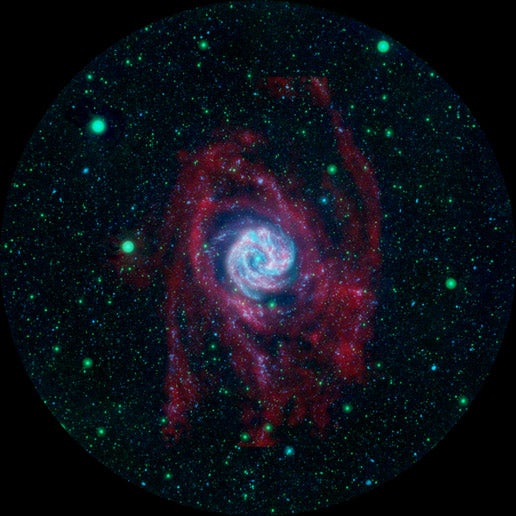A new image from NASA’s Galaxy Evolution Explorer shows baby stars sprouting in the backwoods of a galaxy — a relatively desolate region of space more than 100,000 light-years from the galaxy’s bustling center.
The striking image, a composite of ultraviolet data from the Galaxy Evolution Explorer and radio data from the National Science Foundation’s Very Large Array in New Mexico, shows the Southern Pinwheel galaxy, also known simply as M83.
In the new view, the main spiral, or stellar, disk of M83 looks like a pink and blue pinwheel, while its outer arms appear to flap away from the galaxy like giant red streamers. It is within these so-called extended galaxy arms that, to the surprise of astronomers, new stars are forming.
“It is absolutely stunning that we find such an enormous number of young stars up to 140,000 light-years away from the center of M83,” says Frank Bigiel of the Max Planck Institute for Astronomy in Germany, lead investigator of the new Galaxy Evolution Explorer observations. For comparison, the diameter of M83 is only 40,000 light-years across.
Some of the “outback” stars in M83’s extended arms were first spotted by the Galaxy Evolution Explorer in 2005. Remote stars were also discovered around other galaxies by the ultraviolet telescope over subsequent years. This came as a surprise to astronomers because the outlying regions of a galaxy are assumed to be relatively barren and lack high concentrations of the ingredients needed for stars to form.
The newest Galaxy Evolution Explorer observations of M83 (colored blue and green) were taken over a longer period of time and reveal many more young clusters of stars at the farthest reaches of the galaxy. To better understand how stars could form in such unexpected territory, Bigiel and his colleagues turned to radio observations from the Very Large Array (red). Light emitted in the radio portion of the electromagnetic spectrum can be used to locate gaseous hydrogen atoms, or raw ingredients of stars. When the astronomers combined the radio and Galaxy Evolution Explorer data, they were delighted to see they matched up.
“The degree to which the ultraviolet emission and therefore the distribution of young stars follows the distribution of the atomic hydrogen gas out to the largest distances is absolutely remarkable,” says Fabian Walter, also of the Max Planck Institute for Astronomy, who led the radio observations of hydrogen in the galaxy.
The astronomers speculate that the young stars seen far out in M83 could have formed under conditions resembling those of the early universe, a time when space was not yet enriched with dust and heavier elements.
“Even with today’s most powerful telescopes, it is extremely difficult to study the first generation of star formation. These new observations provide a unique opportunity to study how early generation stars might have formed,” says co-investigator Mark Seibert of the Observatories of the Carnegie Institution of Washington in Pasadena.










